Large Eddy Simulation of Cavitation Jets from an Organ-Pipe Nozzle: The Influence of Cavitation on the Vortex Coherent Structure
Abstract
1. Introduction
2. Materials and Methods
2.1. Multiphase Model
2.1.1. Continuity Equation
2.1.2. Momentum Equation
2.1.3. Energy Equation
2.2. Turbulent LES Governing Equations
Subgrid-Scale Model
2.3. Cavitation Model
2.4. The DMD Algorithm
2.5. Computational Domain and Boundary Conditions
2.6. Model Validation
3. Results
3.1. Outflow Field Characteristics
3.1.1. Pressure Distribution
3.1.2. Frequency Characteristics
3.2. Vortex Structure and Cavitation Characteristics
3.2.1. Coherent Structure of the Outflow Field
3.2.2. Cavitation Characteristic and Vortex Structure at Different Divergence Angles
3.3. DMD-Based Flow Characteristics’ Analysis of External Flow Fields
3.3.1. Vorticity and Velocity Field Modal Analysis of the External Flow Field
3.3.2. Vorticity Modal Decomposition and Volume Fraction Cloud Comparison at x = 0.125 m Cross-Section (Pinlet = 15 MPa, α = 20°)
4. Conclusions
Author Contributions
Funding
Institutional Review Board Statement
Informed Consent Statement
Data Availability Statement
Conflicts of Interest
Abbreviations
| subgrid stress | |
| Sij | rate of the strain tensor |
| Rb | bubble radius |
| Nb | bubble number density |
| Pinlet | inlet pressure |
| average velocity | |
| P | medium pressure |
| v | kinematic viscosity |
| time step | |
| pressure inside the bubble | |
| pressure leaving the bubble at infinity | |
| density of the surrounding liquid | |
| bubble radius | |
| Strouhal number | |
| Df | inlet diameter |
| Dc | cavity diameter |
| De | exit diameter |
| D | free-fluid diameter |
| L | development length |
| Lc | cavity length |
| Le | exit length |
| Lo | free-fluid length |
| α | outlet divergence angle |
| ω | vorticity |
| eigenvalue |
References
- Hu, Y.; Kang, Y.; Wang, X.-C.; Li, X.-H.; Long, X.-P.; Zhai, G.-Y.; Huang, M. Mechanism and experimental investigation of ultra high pressure water jet on rubber cutting. Int. J. Precis. Eng. Manuf. 2014, 15, 1973–1978. [Google Scholar] [CrossRef]
- Ayed, Y.; Robert, C.; Germain, G.; Ammar, A. Development of a numerical model for the understanding of the chip formation in high-pressure water-jet assisted machining. Finite Elem. Anal. Des. 2016, 108, 1–8. [Google Scholar] [CrossRef]
- Xiong, S.; Jia, X.; Wu, S.; Li, F.; Ma, M.; Wang, X. Parameter Optimization and Effect Analysis of Low-Pressure Abrasive Water Jet (LPAWJ) for Paint Removal of Remanufacturing Cleaning. Sustain. Sci. 2021, 13, 2900. [Google Scholar] [CrossRef]
- Hsu, C.-Y.; Liang, C.-C.; Teng, T.-L.; Nguyen, A.-T. A numerical study on high-speed water jet impact. Ocean Eng. 2013, 72, 98–106. [Google Scholar] [CrossRef]
- Zelenak, M.; Foldyna, J.; Scucka, J.; Hloch, S.; Riha, Z. Visualisation and measurement of high-speed pulsating and continuous water jets. Measurement 2015, 72, 1–8. [Google Scholar] [CrossRef]
- Cao, S.; Ge, Z.; Zhang, D.; Zhou, Z.; Lu, Y.; Zhao, H. An experimental study of ultra-high pressure water jet-induced fracture mechanisms and pore size evolution in reservoir rocks. Int. J. Rock Mech. Min. Sci. 2022, 150, 4995. [Google Scholar] [CrossRef]
- Qu, H.; Tang, S.M.; Sheng, M.; Liu, Z.H.; Wang, R.; Hu, Y.S. Experimental investigation of the damage characteristics and breaking process of shale by abrasive waterjet impact. J. Pet. Sci. Eng. 2022, 211, 12. [Google Scholar] [CrossRef]
- Feng, L.; Dong, X.W.; Li, Z.L.; Liu, G.R.; Sun, Z.C. Modeling of Waterjet Abrasion in Mining Processes Based on the Smoothed Particle Hydrodynamics (SPH) Method. Int. J. Comput. Methods 2020, 17, 29. [Google Scholar] [CrossRef]
- Chen, Y.; Fang, Z.; Xiong, T.; Hou, W.; Zhang, Z.; Shi, R. An experimental study on the erosion of sandstone by self-excited oscillation cavitation waterjet in submerged environment. Ocean Eng. 2023, 279, 4546. [Google Scholar] [CrossRef]
- Dehkhoda, S.; Hood, M.; Alehossein, H.; Buttsworth, D. Analytical and Experimental Study of Pressure Dynamics in a Pulsed Water Jet Device. Flow Turbul. Combust. 2012, 89, 97–119. [Google Scholar] [CrossRef]
- Dehkhoda, S.; Hood, M. An experimental study of surface and sub-surface damage in pulsed water-jet breakage of rocks. Int. J. Rock Mech. Min. Sci. 2013, 63, 138–147. [Google Scholar] [CrossRef]
- Dehkhoda, S.; Hood, M. The internal failure of rock samples subjected to pulsed water jet impacts. Int. J. Rock Mech. Min. Sci. 2014, 66, 91–96. [Google Scholar] [CrossRef]
- Hu, D.; Li, X.H.; Tang, C.L.; Kang, Y. Analytical and experimental investigations of the pulsed air-water jet. J. Fluids Struct. 2015, 54, 88–102. [Google Scholar] [CrossRef]
- Cheng, H.-Y.; Ji, B.; Long, X.-P.; Huai, W.-X.; Farhat, M. A review of cavitation in tip-leakage flow and its control. J. Hydrodyn. 2021, 33, 226–242. [Google Scholar] [CrossRef]
- Shi, L.; Zhang, D.; Zhao, R.; Shi, W.; Jin, Y. Effect of blade tip geometry on tip leakage vortex dynamics and cavitation pattern in axial-flow pump. Sci. China Technol. Sci. 2017, 60, 1480–1493. [Google Scholar] [CrossRef]
- Pei, J.H. Study on the Relation Between Oscillation Frequency of Self-excited Oscillation Pulsed Water Jet and Self-excited Pulsed Water Jet Devices. In Proceedings of the International Conference on Materials and Products Manufacturing Technology (ICMPMT 2011), Chengdu, China, 28–30 October 2011; pp. 547–552. [Google Scholar]
- Liu, W.; Kang, Y.; Zhang, M.; Wang, X.; Li, D.; Xie, L. Experimental and theoretical analysis on chamber pressure of a self-resonating cavitation waterjet. Ocean Eng. 2018, 151, 33–45. [Google Scholar] [CrossRef]
- Fang, Z.L.; Gao, X.; Tao, X.; Li, D.; Zhang, M.D.; Xiong, T.; Jiang, P. Impact Performance of Helmholtz Self-Excited Oscillation Waterjets Used for Underground Mining. Appl. Sci. 2019, 9, 3235. [Google Scholar] [CrossRef]
- Wang, X.L.; Kang, Y.; Zhang, M.D.; Yuan, M.; Li, D. The Effects of the Downstream Contraction Ratio of Organ-Pipe Nozzle on the Pressure Oscillations of Self-Resonating Waterjets. Energies 2018, 11, 3137. [Google Scholar] [CrossRef]
- Li, D.; Kang, Y.; Ding, X.L.; Wang, X.C.; Fang, Z.L. Effects of area discontinuity at nozzle inlet on the characteristics of high speed self-excited oscillation pulsed waterjets. Exp. Therm Fluid Sci. 2016, 79, 254–265. [Google Scholar] [CrossRef]
- Li, D.; Kang, Y.; Ding, X.L.; Wang, X.C.; Liu, W.C. Effects of feeding pipe diameter on the performance of a jet-driven Helmholtz oscillator generating pulsed waterjets. J. Mech. Sci. Technol. 2017, 31, 1203–1212. [Google Scholar] [CrossRef]
- Shi, H.Q.; Kang, Y.; Li, D.; Fang, Z.L. Effects of the exit aspect ratio of organ-pipe nozzle on the axial pressure oscillation characteristics of self-resonating waterjet. Proc. Inst. Mech. Eng. Part C J. Mech. Eng. Sci. 2020, 234, 4589–4598. [Google Scholar] [CrossRef]
- Wang, X.C.; Li, Y.Q.; Hu, Y.; Ding, X.L.; Xiang, M.J.; Li, D. An Experimental Study on the Jet Pressure Performance of Organ-Helmholtz (O-H), Self-Excited Oscillating Nozzles. Energies 2020, 13, 367. [Google Scholar] [CrossRef]
- Yuan, M.; Li, D.; Kang, Y.; Shi, H.; Hu, Y. The Characteristics of Self-Resonating Jet Issuing from the Helmholtz Nozzle Combined with a Venturi Tube Structure. J. Appl. Fluid Mech. 2020, 13, 779–791. [Google Scholar] [CrossRef]
- Shi, D.Y.; Xing, Y.L.; Wang, L.F.; Chen, Z. Numerical Simulation and Experimental Research of Cavitation Jets in Dual-Chamber Self-Excited Oscillating Pulsed Nozzles. Shock. Vib. 2022, 2022, 8288. [Google Scholar] [CrossRef]
- Peng, K.W.; Tian, S.C.; Li, G.S.; Huang, Z.W.; Yang, R.Y.; Guo, Z.Q. Bubble dynamics characteristics and influencing factors on the cavitation collapse intensity for self-resonating cavitating jets. Pet. Explor. Dev. 2018, 45, 343–350. [Google Scholar] [CrossRef]
- Soyama, H. High-speed observation of a cavitating jet in air. J. Fluids Eng. Trans. Asme 2005, 127, 1095–1101. [Google Scholar] [CrossRef]
- Li, S.; Li, Y.B.; Zhang, A.M. Numerical analysis of the bubble jet impact on a rigid wall. Appl. Ocean Res. 2015, 50, 227–236. [Google Scholar] [CrossRef]
- Jeffers, N.; Stafford, J.; Conway, C.; Punch, J.; Walsh, E. The influence of the stagnation zone on the fluid dynamics at the nozzle exit of a confined and submerged impinging jet. Exp. Fluids 2016, 57, 17. [Google Scholar] [CrossRef]
- Peng, G.Y.; Oguma, Y.; Shimizu, S. Numerical analysis of cavitation cloud shedding in a submerged water jet. In Proceedings of the 2nd Conference of Global Chinese Scholars on Hydrodynamics (CCSH’ 2016), Wuxi, China, 11–14 November 2016; pp. 263–269. [Google Scholar]
- Liu, W.C.; Kang, Y.; Zhang, M.X.; Wang, X.C.; Li, D. Self-sustained oscillation and cavitation characteristics of a jet in a Helmholtz resonator. Int. J. Heat Fluid Flow 2017, 68, 158–172. [Google Scholar] [CrossRef]
- Liu, W.C.; Kang, Y.; Zhang, M.X.; Zhou, Y.X.; Wang, X.C.; Li, D. Frequency Modulation and Erosion Performance of a Self-Resonating Jet. Appl. Sci. 2017, 7, 932. [Google Scholar] [CrossRef]
- Ge, M.; Petkovšek, M.; Zhang, G.; Jacobs, D.; Coutier-Delgosha, O. Cavitation dynamics and thermodynamic effects at elevated temperatures in a small Venturi channel. Int. J. Heat Mass Transf. 2021, 170, 970. [Google Scholar] [CrossRef]
- Ge, M.; Zhang, G.; Petkovšek, M.; Long, K.; Coutier-Delgosha, O. Intensity and regimes changing of hydrodynamic cavitation considering temperature effects. J. Clean. Prod. 2022, 338, 470. [Google Scholar] [CrossRef]
- Ge, M.; Sun, C.; Zhang, G.; Coutier-Delgosha, O.; Fan, D. Combined suppression effects on hydrodynamic cavitation performance in Venturi-type reactor for process intensification. Ultrason. Sonochem. 2022, 86, 106035. [Google Scholar] [CrossRef] [PubMed]
- Wu, X.-Y.; Zhang, Y.-Q.; Tan, Y.-W.; Li, G.-S.; Peng, K.-W.; Zhang, B. Flow-visualization and numerical investigation on the optimum design of cavitating jet nozzle. Pet. Sci. 2022, 19, 2284–2296. [Google Scholar] [CrossRef]
- Ji, B.; Long, Y.; Long, X.P.; Qian, Z.D.; Zhou, J.J. Large eddy simulation of turbulent attached cavitating flow with special emphasis on large scale structures of the hydrofoil wake and turbulence-cavitation interactions. J. Hydrodyn. 2017, 29, 27–39. [Google Scholar] [CrossRef]
- Ji, B.; Luo, X.W.; Arndt, R.E.A.; Wu, Y.L. Numerical simulation of three dimensional cavitation shedding dynamics with special emphasis on cavitation-vortex interaction. Ocean Eng. 2014, 87, 64–77. [Google Scholar] [CrossRef]
- Cheng, H.Y.; Long, X.P.; Ji, B.; Peng, X.X.; Farhat, M. LES investigation of the influence of cavitation on flow patterns in a confined tip-leakage flow. Ocean Eng. 2019, 186, 106115. [Google Scholar] [CrossRef]
- Deng, L.F.; Long, Y.; Ji, B. Delayed detached eddy simulation and vorticity analysis of cavitating flow around a marine propeller behind the hull. Ocean Eng. 2022, 264, 112442. [Google Scholar] [CrossRef]
- Wang, Z.; Cheng, H.; Ji, B.; Peng, X. Numerical investigation of inner structure and its formation mechanism of cloud cavitating flow. Int. J. Multiph. Flow 2023, 165, 104484. [Google Scholar] [CrossRef]
- Long, X.; Cheng, H.; Ji, B.; Arndt, R.E.A.; Peng, X. Large eddy simulation and Euler–Lagrangian coupling investigation of the transient cavitating turbulent flow around a twisted hydrofoil. Int. J. Multiph. Flow 2018, 100, 41–56. [Google Scholar] [CrossRef]
- Wang, Z.Y.; Cheng, H.Y.; Ji, B. Euler-Lagrange study of cavitating turbulent flow around a hydrofoil. Phys. Fluids 2021, 33, 18. [Google Scholar] [CrossRef]
- Long, Y.; Long, X.; Ji, B.; Xing, T. Verification and validation of Large Eddy Simulation of attached cavitating flow around a Clark-Y hydrofoil. Int. J. Multiph. Flow 2019, 115, 93–107. [Google Scholar] [CrossRef]
- Fang, Z.L.; Zeng, F.D.; Xiong, T.; Wei, W.; Jiang, P.; Wu, Q.; Wang, Y.S.; Fei, Y.X. Large eddy simulation of self-excited oscillation inside Helmholtz oscillator. Int. J. Multiph. Flow 2020, 126, 103253. [Google Scholar] [CrossRef]
- Fang, Z.L.; Wu, Q.; Zhang, M.D.; Liu, H.Y.; Jiang, P.; Li, D. Large Eddy Simulation of Self-Excited Oscillation Pulsed Jet (SEOPJ) Induced by a Helmholtz Oscillator in Underground Mining. Energies 2019, 12, 2161. [Google Scholar] [CrossRef]
- Fang, Z.L.; Wu, Q.; Jiang, P.; Wei, W. Numerical investigation on flow field characteristics of Helmholtz oscillator. In Proceedings of the 29th IAHR Symposium on Hydraulic Machinery and Systems (IAHR), Kyoto, Japan, 16–21 September 2018. [Google Scholar]
- Fang, Z.L.; Kang, Y.; Wang, X.C.; Li, D.; Hu, Y.; Huang, M.; Wang, X.Y. Numerical and experimental investigation on flow field characteristics of organ pipe nozzle. In Proceedings of the 27th IAHR Symposium on Hydraulic Machinery and Systems (IAHR), Montreal, QC, Canada, 22–26 September 2014. [Google Scholar]
- Boguslawski, A.; Tyliszczak, A.; Drobniak, S.; Asendrych, D. Self-sustained oscillations in a homogeneous-density round jet. J. Turbul. 2013, 14, 25–52. [Google Scholar] [CrossRef]
- Wang, G.; Yang, Y.; Wang, C.; Shi, W.; Li, W.; Pan, B. Effect of Nozzle Outlet Shape on Cavitation Behavior of Submerged High-Pressure Jet. Machines 2021, 10, 4. [Google Scholar] [CrossRef]
- Rowley, C.W.; Dawson, S.T.M. Model Reduction for Flow Analysis and Control. In Annual Review of Fluid Mechanics; Davis, S.H., Moin, P., Eds.; Princeton University: Princeton, NJ, USA, 2017; Volume 49, pp. 387–417. [Google Scholar]
- Seena, A.; Sung, H.J. Dynamic mode decomposition of turbulent cavity flows for self-sustained oscillations. Int. J. Heat Fluid Flow 2011, 32, 1098–1110. [Google Scholar] [CrossRef]
- Mariappan, S.; Gardner, A.D.; Richter, K.; Raffel, M. Analysis of Dynamic Stall Using Dynamic Mode Decomposition Technique. AIAA J. 2014, 52, 2427–2439. [Google Scholar] [CrossRef]
- Wan, Z.H.; Zhou, L.; Wang, B.F.; Sun, D.J. Dynamic mode decomposition of forced spatially developed transitional jets. Eur. J. Mech. B 2015, 51, 16–26. [Google Scholar] [CrossRef]
- Mohan, A.T.; Gaitonde, D.V. Analysis of Airfoil Stall Control Using Dynamic Mode Decomposition. J. Aircr. 2017, 54, 1508–1520. [Google Scholar] [CrossRef]
- Larusson, R.; Andersson, N.; Ostlund, J. Dynamic Mode Decomposition of a Separated Nozzle Flow with Transonic Resonance. AIAA J. 2017, 55, 1295–1306. [Google Scholar] [CrossRef]
- Pirozzoli, S.; Bernardini, M.; Marie, S.; Grasso, F. Early evolution of the compressible mixing layer issued from two turbulent streams. J. Fluid Mech. 2015, 777, 196–218. [Google Scholar] [CrossRef][Green Version]
- Yang, L.; Dong, M.; Fu, B.S.; Qiang, L.; Zhang, C.X. Direct numerical simulation of fine flow structures of subsonic-supersonic mixing layer. Aerosp. Sci. Technol. 2019, 95, 105431. [Google Scholar] [CrossRef]
- Xu, Y.; Liu, H.; Wang, Z.; Zhang, J.; Wang, J. Analysis of the Effects of Nozzle Geometry on the Cavitation Water Jet Flow Field Using Orthogonal Decomposition. Iran. J. Sci. Technol. Trans. Mech. Eng. 2023. [Google Scholar] [CrossRef]
- Liang, W.; Chen, T.; Wang, G.; Huang, B. Investigation of unsteady liquid nitrogen cavitating flows with special emphasis on the vortex structures using mode decomposition methods. Int. J. Heat Mass Transf. 2020, 157, 119880. [Google Scholar] [CrossRef]
- Ge, M.; Manikkam, P.; Ghossein, J.; Kumar Subramanian, R.; Coutier-Delgosha, O.; Zhang, G. Dynamic mode decomposition to classify cavitating flow regimes induced by thermodynamic effects. Energy 2022, 254, 124426. [Google Scholar] [CrossRef]
- Lilly, D.K. A proposed modification of the Germano subgrid-scale closure method. Phys. Fluids A 1992, 4, 633–635. [Google Scholar] [CrossRef]
- Cheng, Y.; Chen, Q. Large Eddy Simulation and Dynamic Mode Decomposition of Turbulent Mixing Layers. Appl. Sci. 2021, 11, 12127. [Google Scholar] [CrossRef]
- Kutz, J.N.; Brunton, S.; Brunton, B.W.; Proctor, J.L. Dynamic Mode Decomposition Data-Driven Modeling of Complex Systems; David Marshall: Philadelphia, PA, USA, 2016; pp. 34–37. [Google Scholar]
- Tang, C.L.; Hu, D.; Zhang, F.H. Study on the Frequency Characteristic of Self-Excited Oscillation Pulsed Water Jet. Adv. Mater. Res. 2011, 317–319, 1456–1461. [Google Scholar] [CrossRef]
- Li, D.; Kang, Y.; Ding, X.; Liu, W. Experimental study on the effects of feeding pipe diameter on the cavitation erosion performance of self-resonating cavitating waterjet. Exp. Therm Fluid Sci. 2017, 82, 314–325. [Google Scholar] [CrossRef]
- Cheng, H.; Long, X.; Ji, B.; Peng, X.; Farhat, M. A new Euler-Lagrangian cavitation model for tip-vortex cavitation with the effect of non-condensable gas. Int. J. Multiph. Flow 2021, 134, 103441. [Google Scholar] [CrossRef]
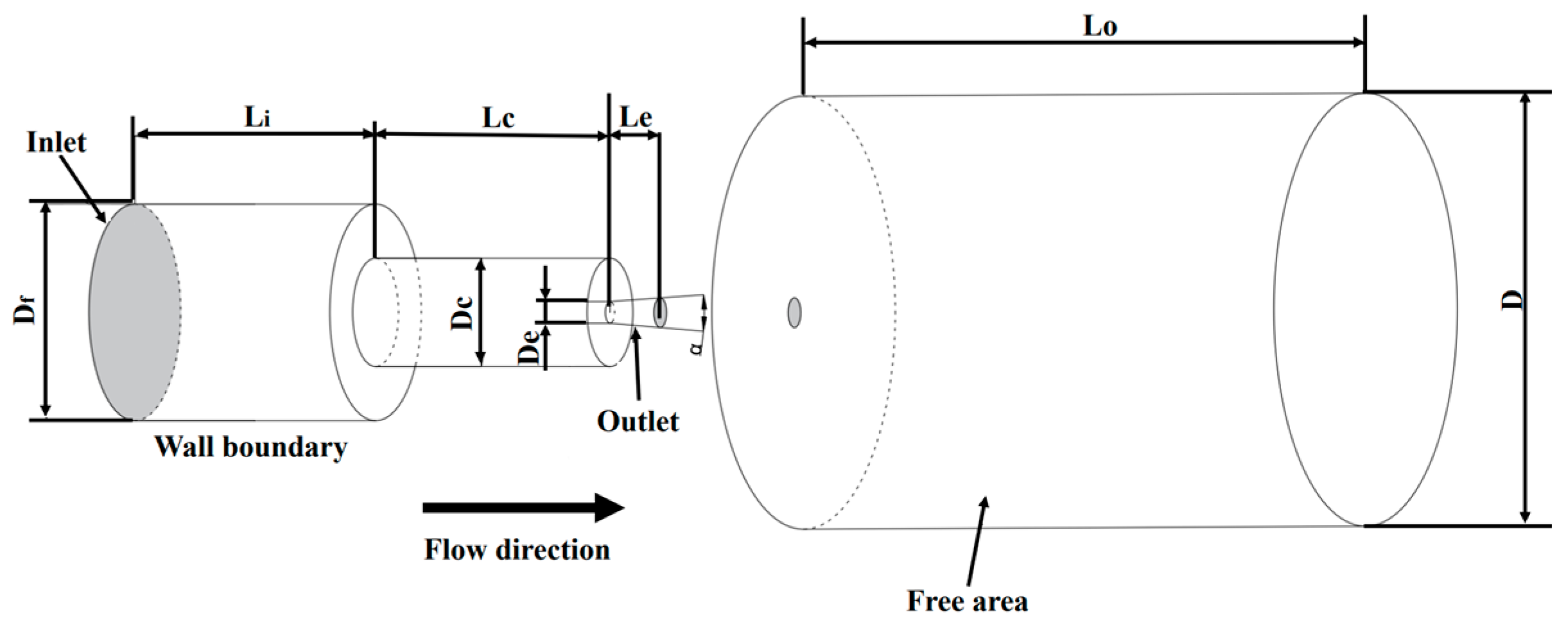
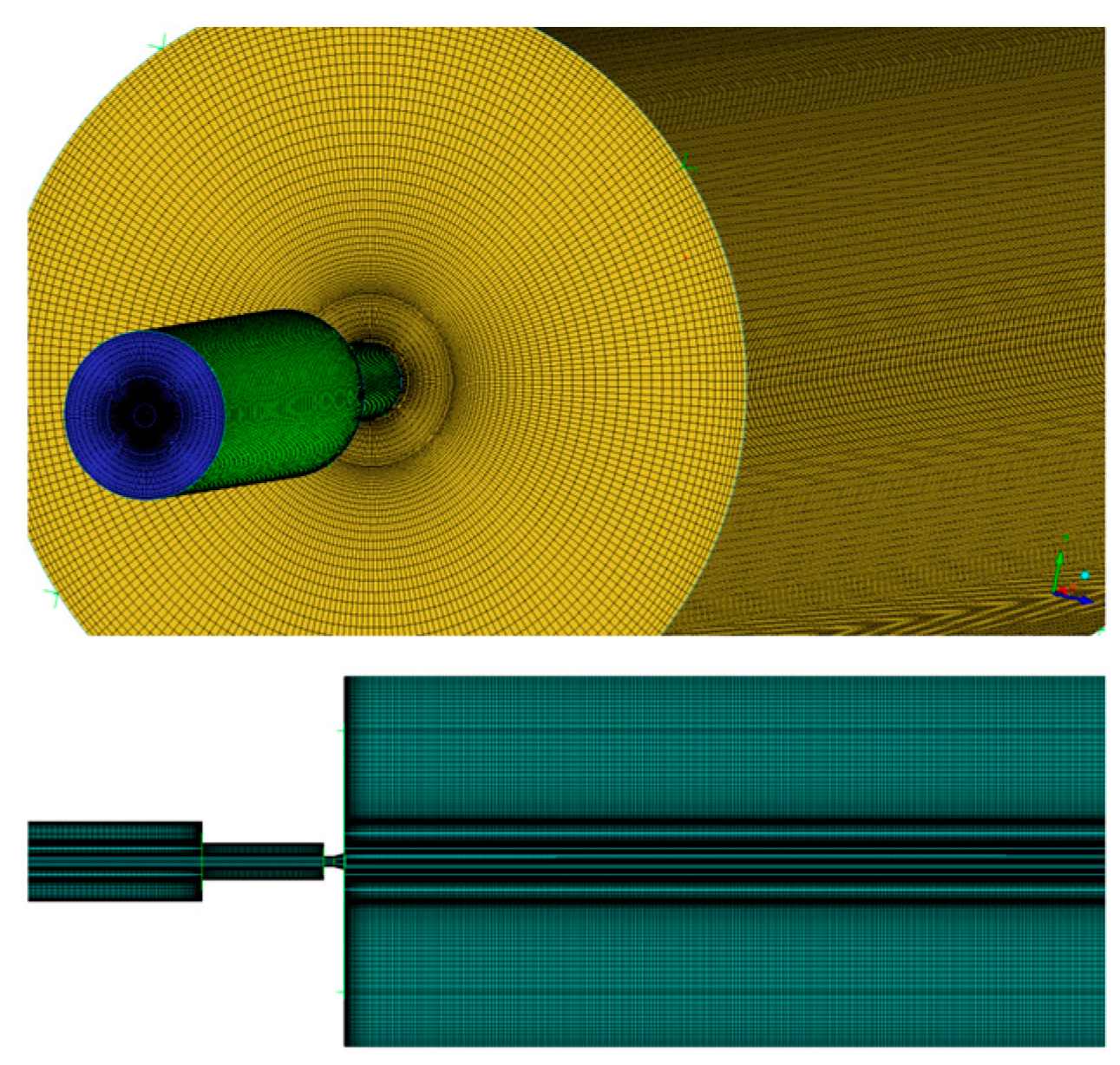
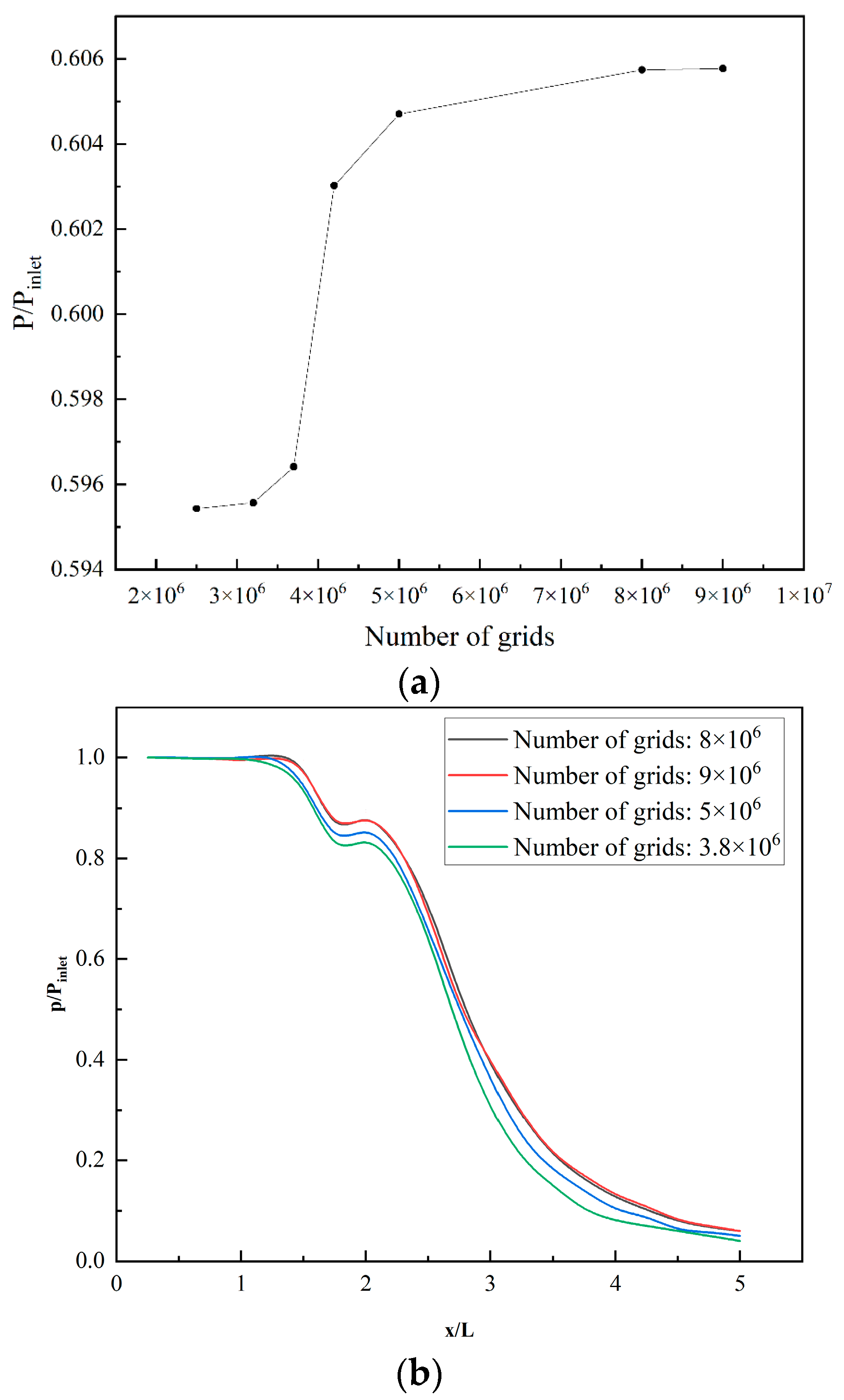
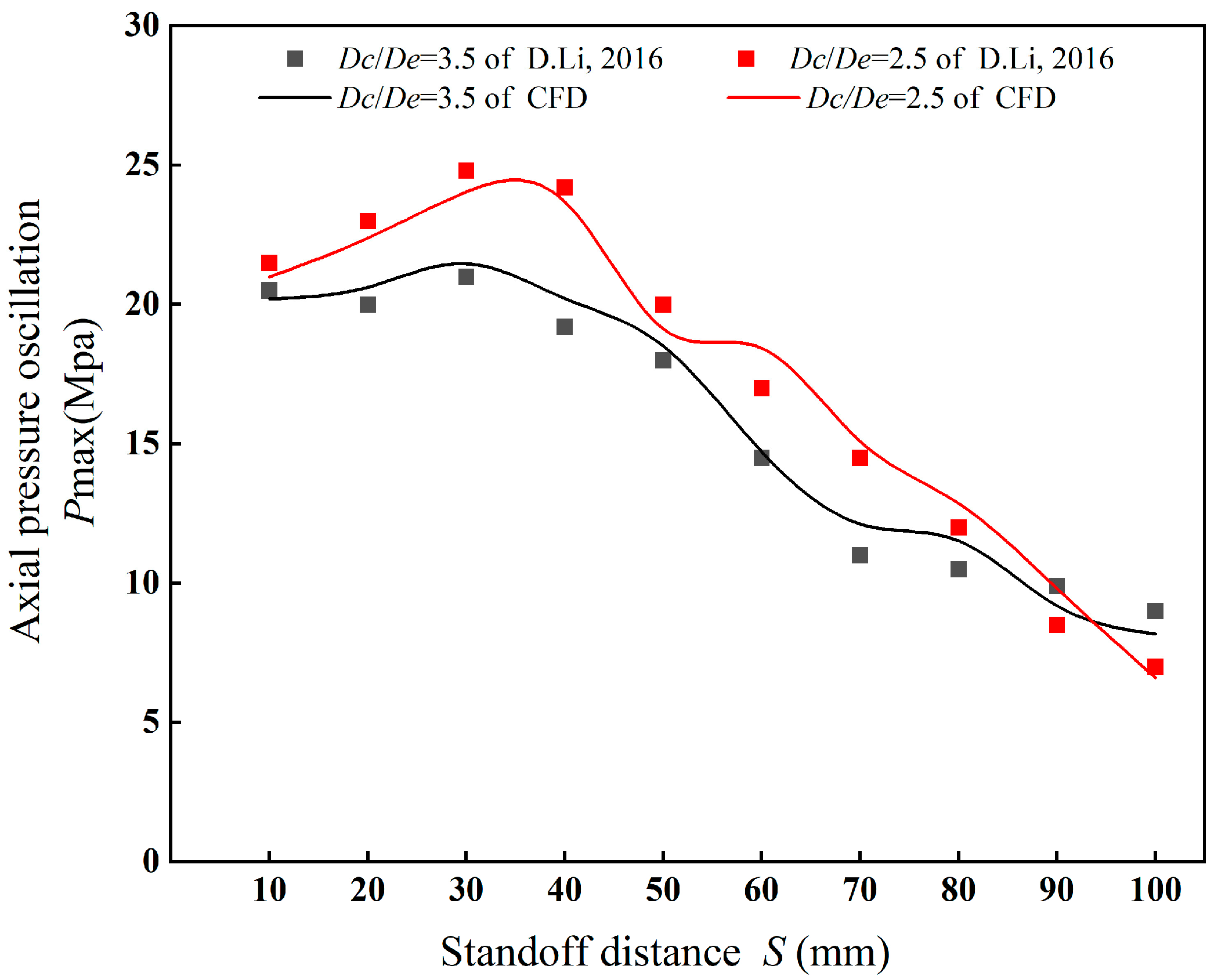
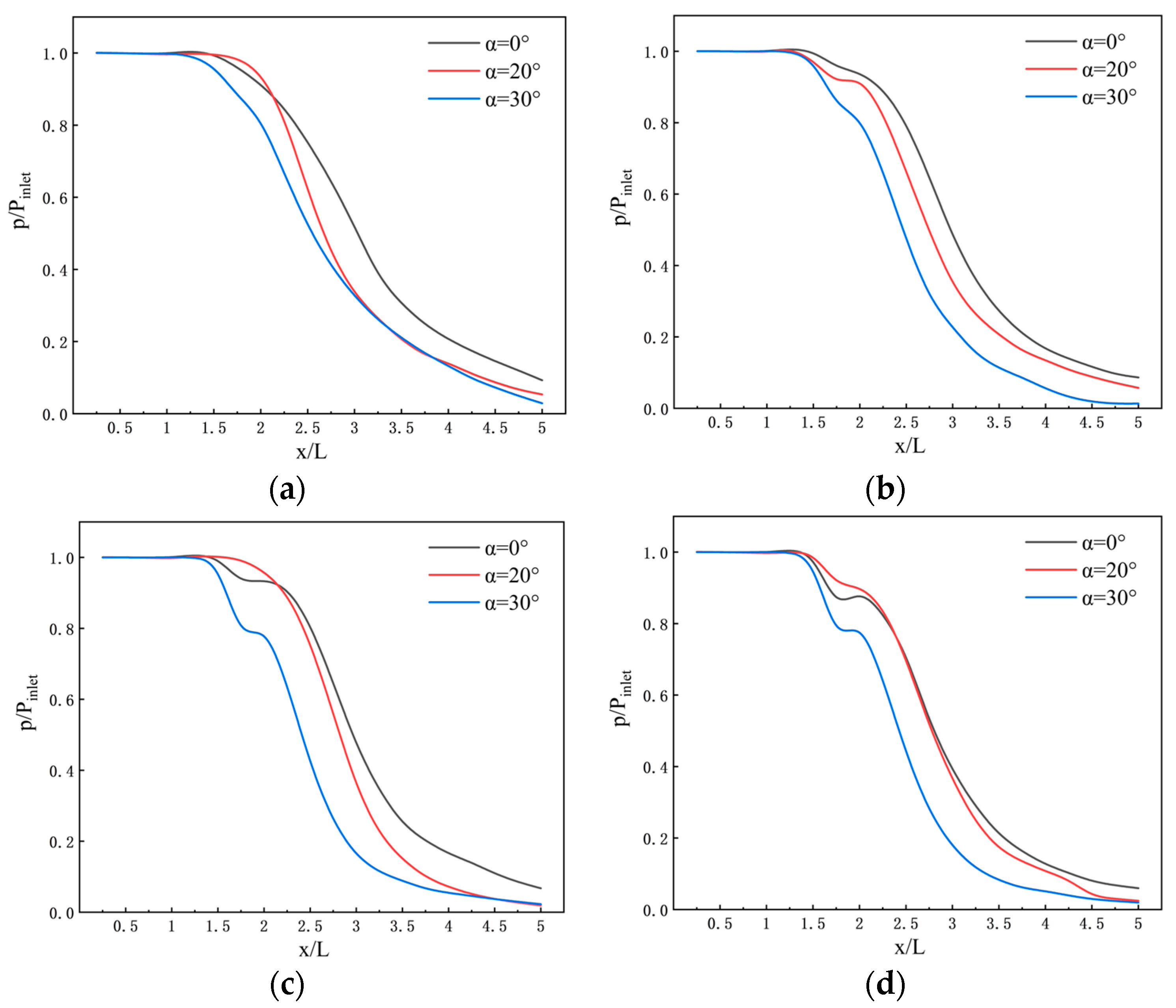

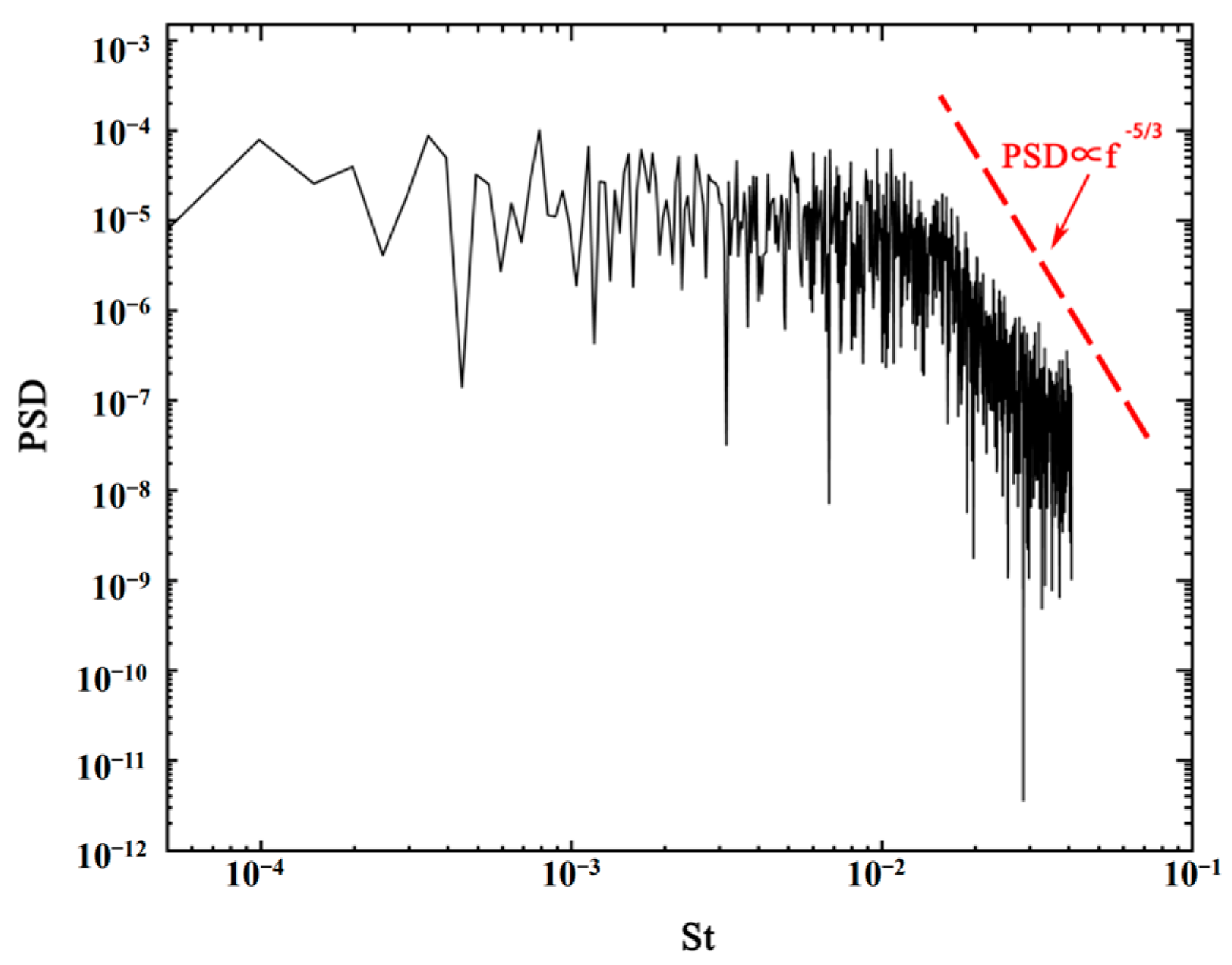
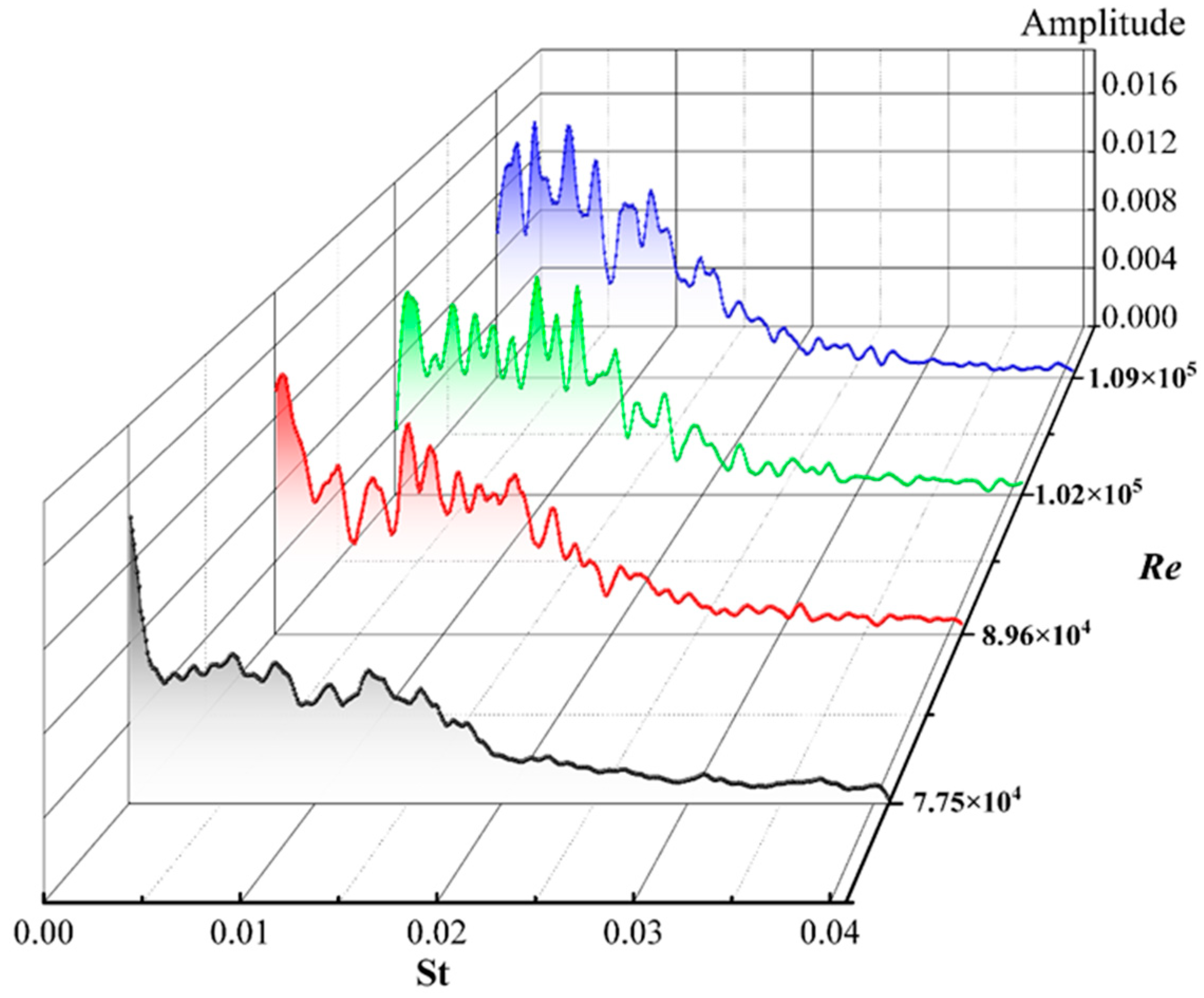

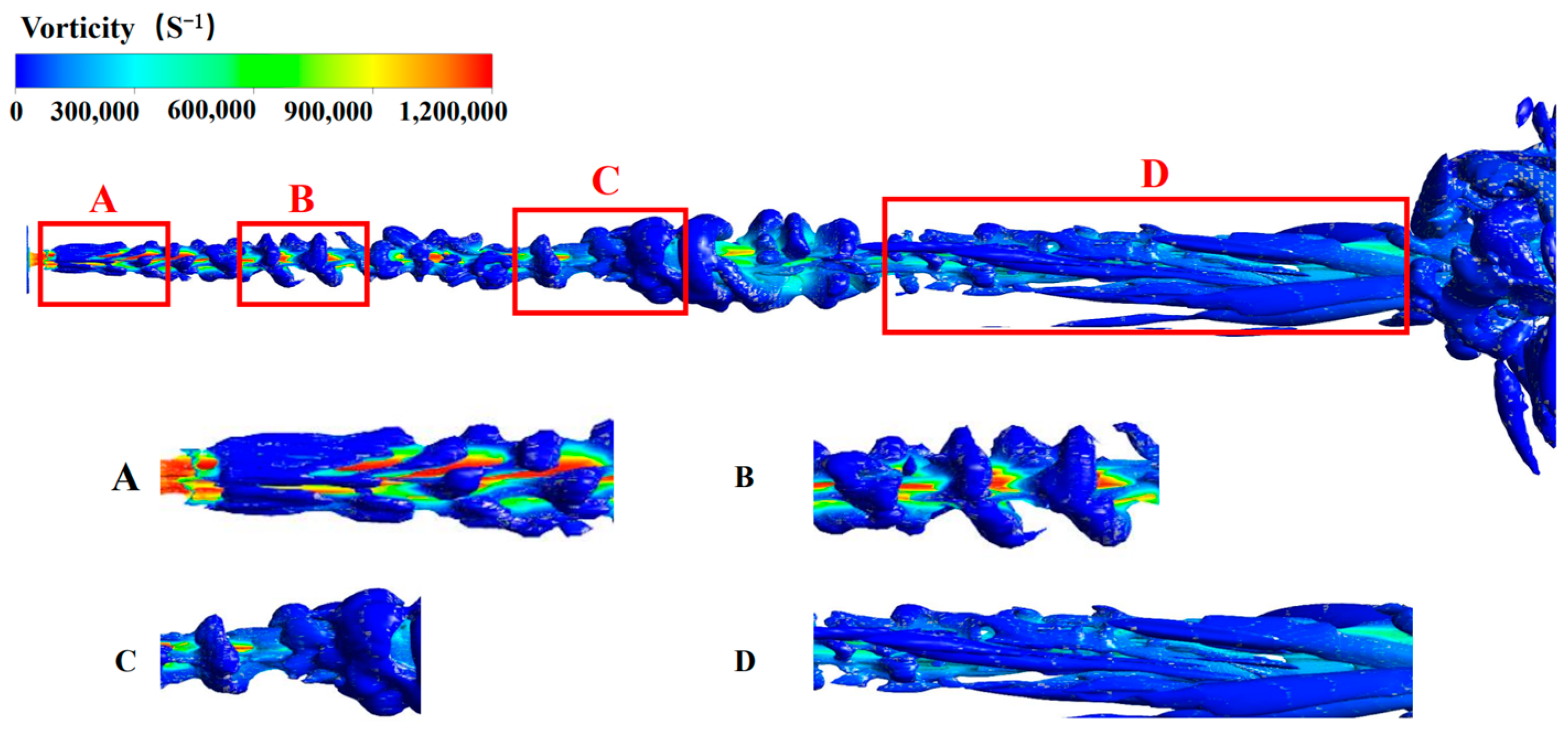
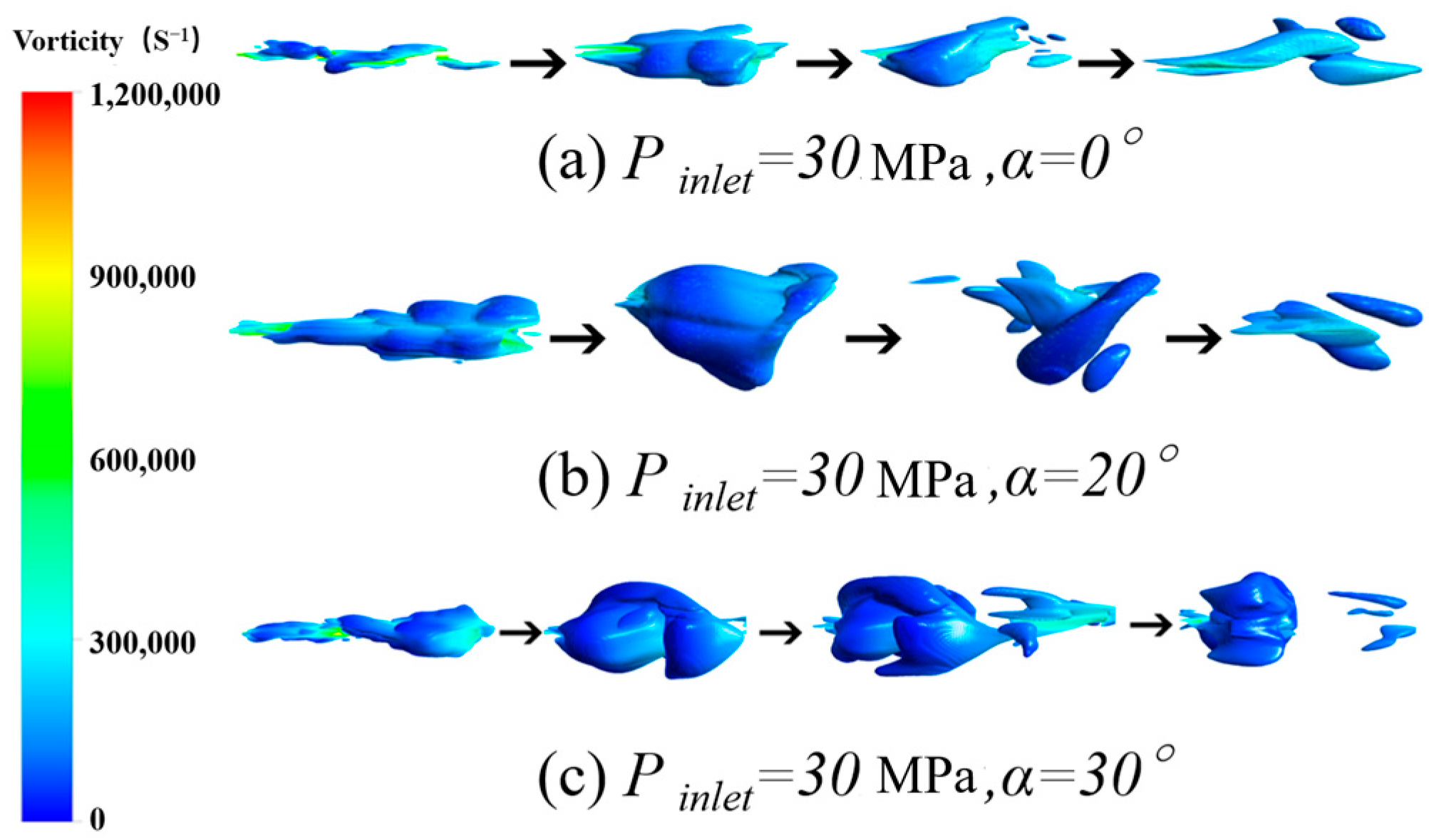



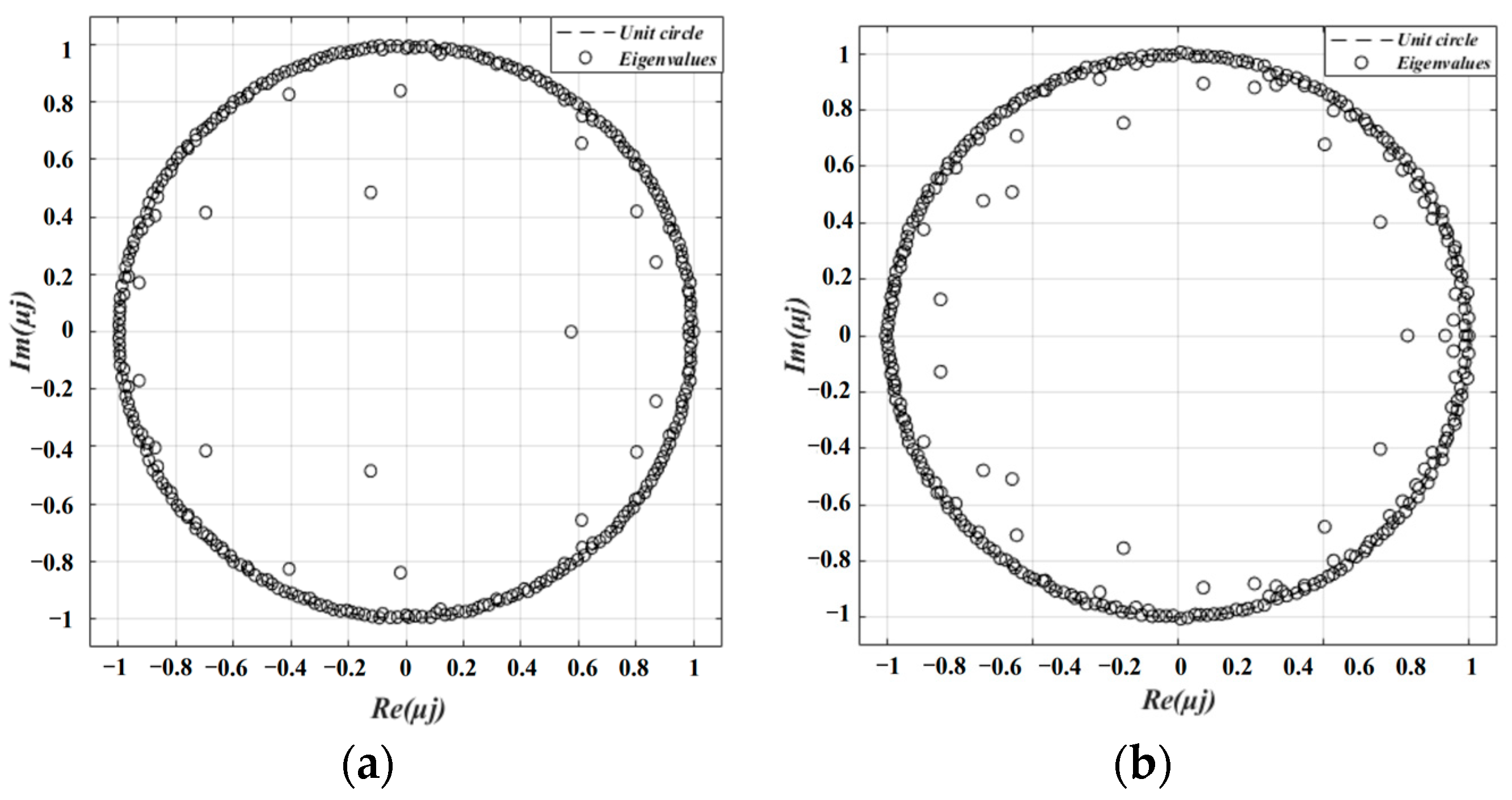
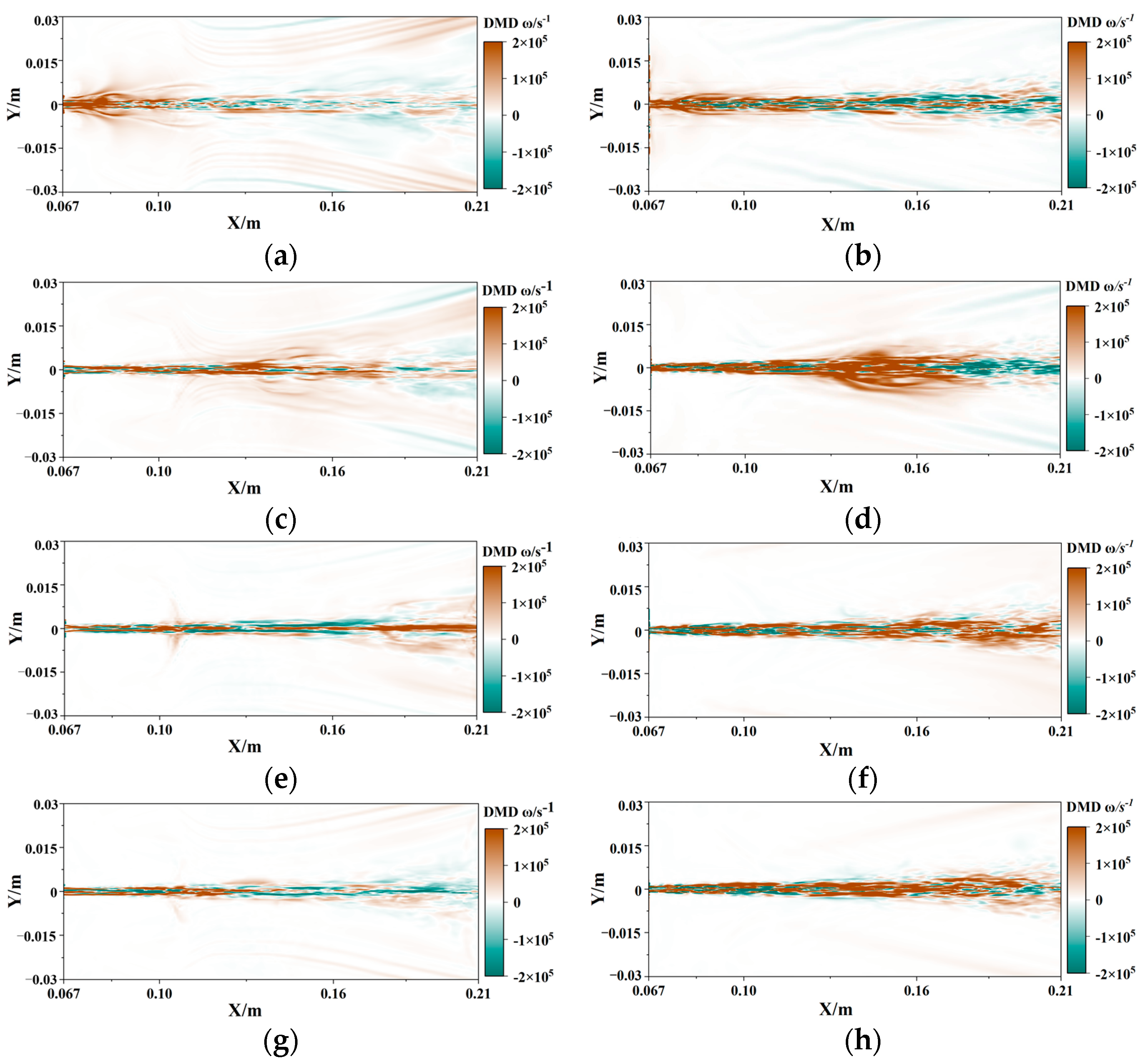
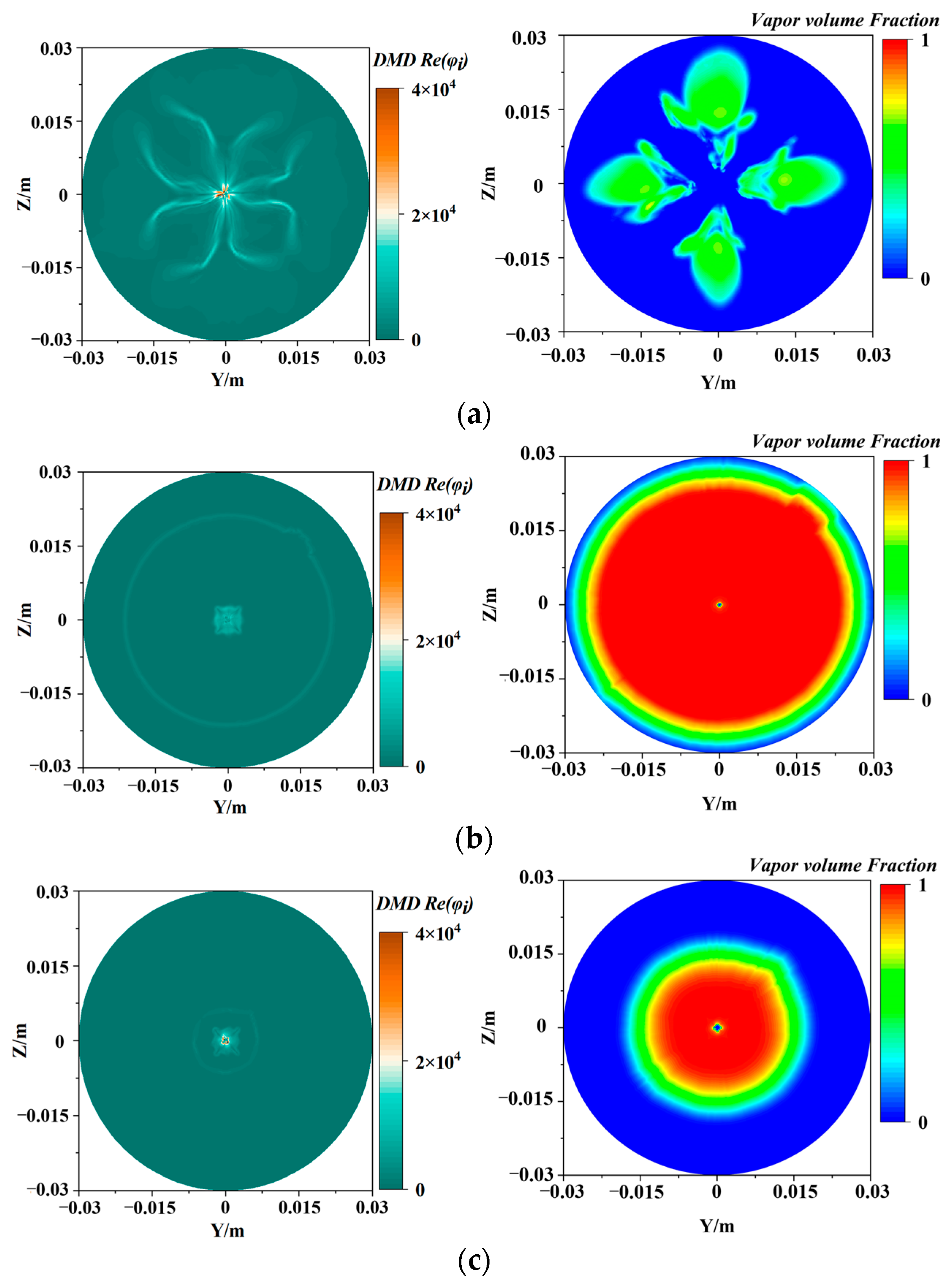
| Parameter | Value |
|---|---|
| Df (mm) | 15 |
| Dc (mm) | 7 |
| De (mm) | 2 |
| D (mm) | 70 |
| L (mm) | 40 |
| Lc (mm) | 23 |
| Le (mm) | 2 |
| Lo (mm) | 150 |
| α (°) | 0, 20, 30 |
| Parameter | Value |
|---|---|
| 10 | |
| 20 | |
| 13 | |
| 2 | |
| 2.5 | |
| 3 | |
| 3.5 | |
| 2 | |
| 21 | |
| 10 |
| DMD Mode | Growth Rate | Frequency (Hz) |
|---|---|---|
| 1 | −0.7302 | 0.6860 |
| 2 | −0.9258 | 0.3795 |
| 3 | −0.9601 | −0.2737 |
| 4 | −0.9869 | 0.1602 |
| DMD Mode | Growth Rate | Frequency (Hz) |
|---|---|---|
| 1 | 0.8608 | 0.5216 |
| 2 | 0.9519 | 0.2992 |
| 3 | 0.9969 | −0.1516 |
| 4 | 1 | 0 |
Disclaimer/Publisher’s Note: The statements, opinions and data contained in all publications are solely those of the individual author(s) and contributor(s) and not of MDPI and/or the editor(s). MDPI and/or the editor(s) disclaim responsibility for any injury to people or property resulting from any ideas, methods, instructions or products referred to in the content. |
© 2023 by the authors. Licensee MDPI, Basel, Switzerland. This article is an open access article distributed under the terms and conditions of the Creative Commons Attribution (CC BY) license (https://creativecommons.org/licenses/by/4.0/).
Share and Cite
Fang, Z.; Hou, W.; Xu, Z.; Guo, X.; Zhang, Z.; Shi, R.; Yao, Y.; Chen, Y. Large Eddy Simulation of Cavitation Jets from an Organ-Pipe Nozzle: The Influence of Cavitation on the Vortex Coherent Structure. Processes 2023, 11, 2460. https://doi.org/10.3390/pr11082460
Fang Z, Hou W, Xu Z, Guo X, Zhang Z, Shi R, Yao Y, Chen Y. Large Eddy Simulation of Cavitation Jets from an Organ-Pipe Nozzle: The Influence of Cavitation on the Vortex Coherent Structure. Processes. 2023; 11(8):2460. https://doi.org/10.3390/pr11082460
Chicago/Turabian StyleFang, Zhenlong, Wenjiang Hou, Zhifan Xu, Xiaofeng Guo, Zenglei Zhang, Ruichao Shi, Yunan Yao, and Yong Chen. 2023. "Large Eddy Simulation of Cavitation Jets from an Organ-Pipe Nozzle: The Influence of Cavitation on the Vortex Coherent Structure" Processes 11, no. 8: 2460. https://doi.org/10.3390/pr11082460
APA StyleFang, Z., Hou, W., Xu, Z., Guo, X., Zhang, Z., Shi, R., Yao, Y., & Chen, Y. (2023). Large Eddy Simulation of Cavitation Jets from an Organ-Pipe Nozzle: The Influence of Cavitation on the Vortex Coherent Structure. Processes, 11(8), 2460. https://doi.org/10.3390/pr11082460









